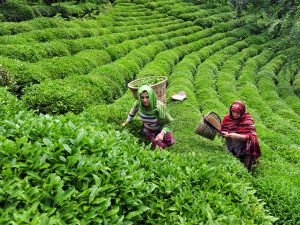Wondering What Is The Economically Important Part Of The Tea Plant? Well,Tea, derived from the Camellia sinensis plant, is one of the most popular and widely consumed beverages in the world.
Its rich history, cultural significance, and numerous health benefits have made it an integral part of daily life for millions of people.
When it comes to the economically important part of the tea plant, it is the leaves that take center stage.
In this article, we will explore the various aspects of tea leaves and their significance in the tea industry.
What Is The Economically Important Part Of The Tea Plant?
1. More Than Just A Hot Beverage
Tea is more than just a hot beverage; it is an experience that encompasses history, tradition, and a myriad of flavors. To understand the economically important part of the tea plant, we must delve into the world of tea leaves.
2. The Tea Plant: A Brief Overview
The Camellia sinensis plant, native to East Asia, is the source of all true teas. It is a perennial evergreen shrub that thrives in regions with a suitable climate, altitude, and soil conditions.
3. The Tea Leaf: Nature’s Treasure
The tea leaf is the epitome of the tea plant’s economic significance. It is in the tender young leaves that the plant’s essential oils, flavor compounds, and bioactive substances are concentrated.
4. Cultivation and Harvesting Techniques
Tea cultivation requires meticulous care and attention. Farmers employ various techniques to ensure optimal growth, including pruning, fertilizing, and pest control. Harvesting methods differ depending on the type of tea being produced.
5. Processing the Leaves: From Plucking to Packaging
Once the leaves are harvested, they undergo processing to transform them into the tea we know and love. This involves withering, rolling, oxidation, and drying. Each step contributes to the flavor, aroma, and appearance of the final product.
6. Grades of Tea Leaves: A Mark of Quality
Tea leaves are graded based on their quality and appearance. The grading system helps buyers and consumers identify the characteristics of different teas, from delicate white teas to robust black teas.
7. Health Benefits of Tea Consumption
Tea is not only a delicious beverage but also offers numerous health benefits. From boosting metabolism and aiding digestion to providing antioxidants and promoting relaxation, tea has long been associated with well-being.
8. Global Tea Industry and Economic Impact
The tea industry is a major player in the global economy. It supports millions of livelihoods, from small-scale farmers to large-scale plantations, and contributes significantly to the GDP of tea-producing countries.
9. Innovations and Trends in Tea Production
To meet the demands of modern consumers, the tea industry has witnessed several innovations and trends. From flavored teas and ready-to-drink options to sustainable packaging and organic production, the sector continues to evolve.
10. Sustainability and Fair Trade Practices
As the tea industry grows, the importance of sustainability and fair trade practices becomes paramount. Initiatives promoting environmental stewardship, social responsibility, and ethical sourcing are gaining momentum.
11. Tea Culture and Rituals Around the World
Tea has deep cultural roots in various countries, each with its unique customs and rituals. Exploring tea culture provides a glimpse into the diverse ways people connect with this beloved beverage.
12. Tea Tourism: Exploring the Tea Gardens
Tea tourism offers an immersive experience for tea enthusiasts. Visitors can explore picturesque tea gardens, learn about the tea-making process, and even participate in tea tastings.
13. Tea and Gastronomy: Pairing Flavors
Tea’s versatility extends beyond a standalone drink. It can be paired with different foods to create harmonious flavor combinations. Discovering the art of tea and food pairing opens up a world of culinary possibilities.
14. Tea in the Digital Age: Online Tea Communities
The internet has given rise to online tea communities, where tea lovers can share their passion, exchange knowledge, and connect with like-minded individuals from around the globe. These communities foster a sense of camaraderie among tea enthusiasts.
FAQs
- What are the different types of tea?
- Green tea, black tea, white tea, oolong tea, and herbal tea are some of the popular types of tea.
- How long does it take for tea leaves to grow?
- Tea leaves typically take around three to four years to reach maturity and be ready for harvesting.
- Are there any caffeine-free teas?
- Yes, herbal teas, such as chamomile and peppermint, are naturally caffeine-free.
- What is the best way to store tea leaves?
- To preserve the freshness and flavor of tea leaves, store them in an airtight container away from light, heat, and moisture.
- Can tea leaves be reused for multiple infusions?
- Yes, certain types of tea leaves, such as loose-leaf teas, can be infused multiple times, offering different flavors with each brew.
Conclusion
Tea leaves, the economically important part of the tea plant, have a significant impact on the global tea industry.
From cultivation to processing, the journey of tea leaves involves intricate techniques, craftsmanship, and a deep appreciation for nature’s bounty. As tea continues to captivate the world, its economic importance remains undeniable.
Recent Posts
Benin Coup Bombshell Soldiers Announce Seizure Of Power On National TV
On 7 December 2025, soldiers in Benin appeared live on national television and announced that they had seized power from the country’s elected government. The announcement shocked the nation and...
Snowfall patterns across the United States vary wildly, with northern regions regularly blanketed in white while southern states often go years without a single flake. Because of this variability,...